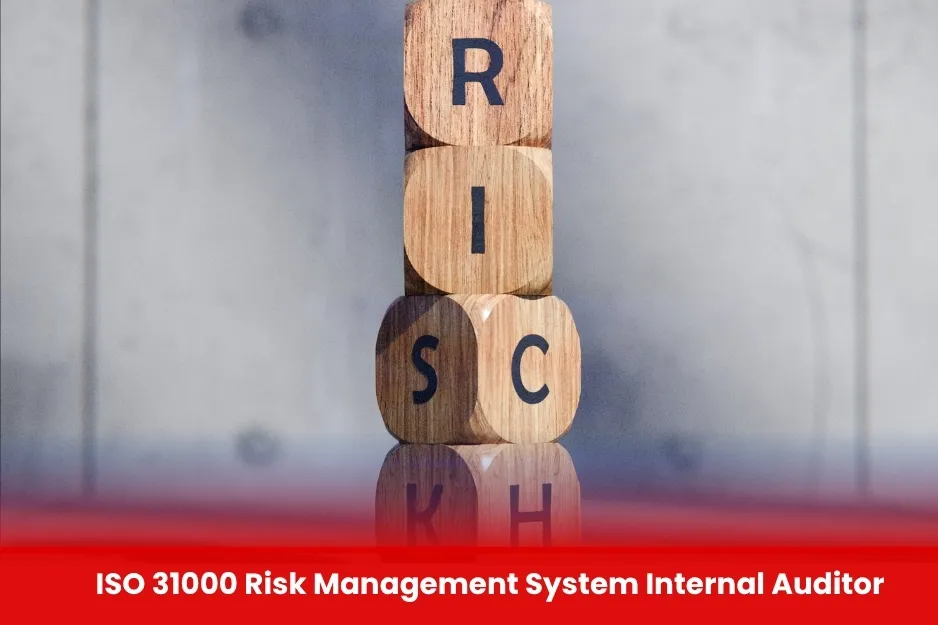ISO 31000 Risk Management System Internal Auditor
ISO 31000 is the international standard for risk management, offering principles, a framework, and a process for managing risk effectively across any organization or sector. It helps organizations identify, assess, and mitigate risks to achieve strategic and operational objectives.
The ISO 31000 Internal Auditor training is designed to develop the skills and knowledge required to audit risk management systems against the principles and guidelines of ISO 31000. This course provides practical guidance on how to assess an organization’s risk management framework, ensure its effectiveness, and recommend improvements.

Aim of ISO 31000 Risk Management System Internal Auditor
The aim of this training is to:
- Provide participants with the knowledge and skills required to conduct effective internal audits of a risk management system based on the principles and framework of ISO 31000.
- Equip professionals with tools to evaluate the effectiveness of risk management policies, procedures, and controls within an organization.
- Enhance understanding of risk identification, assessment, treatment, monitoring, and communication processes.
- Ensure that internal auditors can contribute to continuous improvement and informed decision-making by identifying risk-related gaps and nonconformities.
- Align internal audit practices with ISO 19011 guidelines to ensure a systematic, evidence-based approach to auditing.
Course Overview
ISO 31000 Risk Management System Internal Auditor
Total Modules 6
Training Credits 18
Directed Learning Hours (DLH) 90
Course Code BUK1945
- Risk Management Professionals
- Internal Auditors or Audit Team Members
- Compliance and Governance Officers
- Quality Managers / QHSE Professionals
- Operations and Project Managers
- Finance, Procurement, or HR Managers involved in risk oversight
- Consultants and Trainers working in enterprise risk, strategy, or ISO systems
- Legal and Regulatory Officers
- Management System Representatives responsible for integrated systems
| Course Code | Curriculum Title | Credit | DLH |
|---|---|---|---|
| BUK1945-1 | Introduction to Risk Management and ISO 31000 | 3 | 15 |
| BUK1945-2 | ISO 31000 Framework and Principles | 3 | 15 |
| BUK1945-3 | Risk Management Process (Clause 6) | 3 | 15 |
| BUK1945-4 | Introduction to Auditing (Based on ISO 19011:2018) | 3 | 15 |
| BUK1945-5 | Audit Planning and Preparation | 3 | 15 |
| BUK1945-6 | Conducting the Risk Management Audit | 3 | 15 |
Module 1: Introduction to Risk Management and ISO 31000
- Overview of ISO 31000:2018
- Key definitions, principles, and terminology
- Importance of risk management in organizations
- Scope and structure of the ISO 31000 standard
Module 2: ISO 31000 Framework and Principles
- The 8 principles of risk management
- Understanding the risk management framework
- Integration of risk management into organizational processes
- Leadership and commitment in managing risk
Module 3: Risk Management Process (Clause 6)
- Risk identification techniques
- Risk analysis and evaluation
- Risk treatment and response strategies
- Risk monitoring and review
- Communication and consultation in the risk process
Module 4: Introduction to Auditing (Based on ISO 19011:2018)
- Types and objectives of audits (1st, 2nd, 3rd party)
- Principles of auditing
- Auditor roles, ethics, and responsibilities
- Risk-based thinking in auditing
Module 5: Audit Planning and Preparation
- Establishing an internal audit program
- Determining audit scope, objectives, and criteria
- Developing audit checklists and questionnaires
- Reviewing relevant documentation
Module 6: Conducting the Risk Management Audit
- Performing audit interviews and collecting evidence
- Observations, document reviews, and sampling techniques
- Identifying nonconformities, opportunities for improvement
- Real-time risk-focused audit decision-making
Module 7: Audit Reporting and Follow-up
- Structuring the audit report
- Categorizing and documenting audit findings
- Holding the closing meeting
- Follow-up on corrective actions and continual improvement
Module 8: Case Studies and Practical Exercises
- Scenario-based auditing of risk processes
- Group activities for risk assessment and internal audit simulation
- Drafting nonconformity reports
- Peer review and feedback
- Risk Managers / Risk Officers
- Internal Auditors and Audit Team Members
- Compliance Officers
- Governance and Corporate Strategy Professionals
- Quality, Health, Safety & Environment (QHSE) Managers
- Project and Operations Managers
- Legal and Regulatory Affairs Personnel
- ISO Coordinators / Management System Representatives
- Consultants and Trainers in Risk, ISO Standards, or Auditing
- Business Continuity and Enterprise Risk Planners
- All Modules within this qualification are assessed internally by the approved training Centre and externally verified by BURRAQ UK. The program uses a criterion-referenced assessment approach to ensure that learners successfully meet all required learning outcomes.
- A Pass in any unit is granted only when the learner submits valid, reliable, and authentic evidence that demonstrates achievement of the assessment criteria. The Assessor is responsible for reviewing this evidence and confirming that the learner has attained the expected standard.
